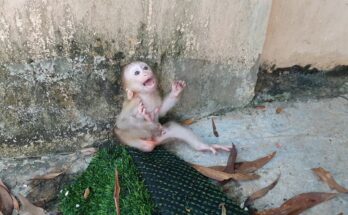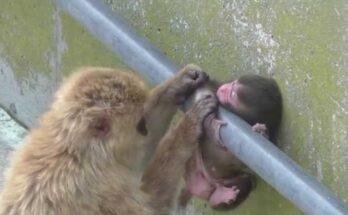In a lively corner of the monkey troop’s home, chaos suddenly breaks out. Seven tiny baby monkeys, each still learning their way around the world, are huddled together on the ground. Their playful chatter turns into loud, high-pitched screams as a large, intimidating monkey approaches. The big monkey’s size alone is enough to frighten the little ones, but its stern and dominant posture makes the moment even more tense.
The babies, normally full of curiosity and energy, now press closer to each other for safety. Their wide eyes dart between the big monkey and one another, as if silently asking what will happen next. Some cling tightly to the nearest friend, while others wrap their tiny arms around their own bodies, trembling in nervous anticipation. The big monkey, possibly an older member of the troop or a rival from another group, stands tall and still, its gaze fixed on the little ones.
The screaming grows louder—sharp, rapid bursts that echo through the area. It’s a chorus of fear and helplessness, each tiny voice blending into a collective cry for safety. The troop’s natural hierarchy is clear here: the big monkey commands presence, while the small ones must tread carefully. But their fear isn’t entirely unfounded. Larger monkeys sometimes assert dominance in harsh ways—by chasing, grabbing, or even pushing the smaller ones aside to claim space or food.
A brave baby monkey in the group steps slightly forward, not to challenge, but to peek and understand the big monkey’s intentions. The giant figure shifts, making a sudden movement toward the babies, and that’s enough to send the group scrambling. Tiny feet patter frantically against the dirt and dry leaves, some climbing low branches while others hide behind rocks and tree roots.
Still, not all of the young ones manage to escape immediately. A couple remain frozen, their little bodies stiff with fear, their screams rising even higher. The big monkey pauses—perhaps just asserting its authority rather than intending to harm. After a few moments of silent standoff, the older monkey turns its head, scanning the surroundings. It then walks away slowly, leaving behind the echoes of the babies’ cries.
Relieved, the young monkeys cautiously emerge from their hiding spots. They gather again, nervously glancing around to make sure the coast is clear. Their screams fade into softer whimpers and quiet chatter as they begin to comfort each other, touching faces and holding hands in the way only monkeys can. The moment has passed, but the tension still lingers in the air.
This short but intense encounter shows the delicate balance of life in a monkey troop. For the young, every day is a lesson in survival—learning who to trust, when to stay close, and when to run. And for these seven baby monkeys, the big monkey’s visit will not soon be forgotten. It was a moment that tested their courage, reminded them of their vulnerability, and brought them closer together in their shared fear and relief.


